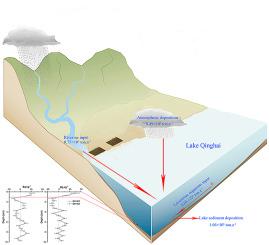Chemosphere ( IF 8.1 ) Pub Date : 2020-07-03 , DOI: 10.1016/j.chemosphere.2020.127489 Qiugui Wang , Zhanjiang Sha , Jinlong Wang , Qiangqiang Zhong , Penggao Fang , Yujun Ma , Jinzhou Du

|
Radionuclides are widely used to perform geochronologic investigations of the trace sediment deposition process in aquatic environments on different temporal scales. This study presents the activities of radionuclides to select a reasonable geochronologic dating method and study the sediment depositional environment in Lake Qinghai on the Qinghai-Tibet Plateau. The range of activities (Bq.kg-1) of 137Cs, 226Ra, 238U, 228Ra, 228Th, and 40K were 2-103, 24-49, 33-156, 20-49, 30-50, and 403-664, respectively. The sedimentation flux was calculated as 1.66 × 106 ton.a-1 based on the summary sedimentation rate in Lake Qinghai, and the sediment contributions from rivers, authigenic carbonates, lacustrine organisms, and atmospheric deposition were 45.18%, 22.44%, 3.02%, and 29.36%, respectively. The decreased 226Ra/238U radioactivity ratios from the catchment to the lake centre indicated that the removal of uranium relative to its daughter products occurs during erosion processes. The positive 228Thex (excess 228Th) values in the upper 1 cm of the sediment suggested that the sediment in the top 1 cm have been resuspended, mixed and/or transported. The distribution of 137Cs in the sediments indicated that the maximum activity of 137Cs in the sediments corresponds to the 1963 peak in the global fallout from atmospheric nuclear weapons testing; moreover, the 1986 Chernobyl accident signal was difficult to identify. The use of 137Cs as a chronologic tool must be performed carefully due to its migration process in sediments.
中文翻译:

青藏高原青海湖中放射性核素的垂直分布及其环境意义
放射性核素被广泛用于对水生环境中不同时间尺度的痕量沉积物沉积过程进行地质年代学调查。本研究介绍了放射性核素的活动,以选择一种合理的年代学测年方法,并研究青藏高原青海湖的沉积物沉积环境。137 Cs,226 Ra,238 U,228 Ra,228 Th和40 K的活度(Bq.kg -1)为2-103、24-49、33-156、20-49、30-50 ,和403-664。沉降通量经计算为1.66×10 6吨a -1根据青海湖的总体沉积率,河流,自生碳酸盐,湖相生物和大气沉积物的沉积贡献分别为45.18%,22.44%,3.02%和29.36%。从流域到湖泊中心的226 Ra / 238 U放射性比值降低表明,相对于其子产物,铀的去除发生在侵蚀过程中。正极228的Th EX(过量228 TH)在上1厘米沉积物值建议,在顶部1厘米沉淀重新悬浮,混合和/或运输。137 Cs在沉积物中的分布表明最大的137活度沉积物中的Cs对应于1963年大气核武器试验在全球尘埃中的峰值。此外,1986年的切尔诺贝利事故信号很难识别。由于137 Cs在沉积物中的迁移过程,因此必须谨慎地使用137 Cs作为年代学工具。











































 京公网安备 11010802027423号
京公网安备 11010802027423号